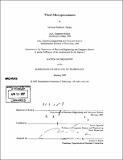Tiled microprocessors
Author(s)
Taylor, Michael Bedford, 1975-
DownloadFull printable version (63.06Mb)
Other Contributors
Massachusetts Institute of Technology. Dept. of Electrical Engineering and Computer Science.
Advisor
Anant Agarwal.
Terms of use
Metadata
Show full item recordAbstract
Current-day microprocessors have reached the point of diminishing returns due to inherent scalability limitations. This thesis examines the tiled microprocessor, a class of microprocessor which is physically scalable but inherits many of the desirable properties of conventional microprocessors. Tiled microprocessors are composed of an array of replicated tiles connected by a special class of network, the Scalar Operand Network (SON), which is optimized for low-latency, low-occupancy communication between remote ALUs on different tiles. Tiled microprocessors can be constructed to scale to 100's or 1000's of functional units. This thesis identifies seven key criteria for achieving physical scalability in tiled microprocessors. It employs an archetypal tiled microprocessor to examine the challenges in achieving these criteria and to explore the properties of Scalar Operand Networks. The thesis develops the field of SONs in three major ways: it introduces the 5-tuple performance metric, it describes a complete, high-frequency <0,0,1,2,0> SON implementation, and it proposes a taxonomy, called AsTrO, for categorizing them. (cont.) To develop these ideas, the thesis details the design, implementation and analysis of a tiled microprocessor prototype, the Raw Microprocessor, which was implemented at MIT in 180 nm technology. Overall, compared to Raw, recent commercial processors with half the transistors required 30x as many lines of code, occupied 100x as many designers, contained 50x as many pre-tapeout bugs, and resulted in 33x as many post-tapeout bugs. At the same time, the Raw microprocessor proves to be more versatile in exploiting ILP, stream, and server-farm workloads with modest to large amounts of parallelism.
Description
Thesis (Ph. D.)--Massachusetts Institute of Technology, Dept. of Electrical Engineering and Computer Science, 2007. Includes bibliographical references (p. 251-258).
Date issued
2007Department
Massachusetts Institute of Technology. Department of Electrical Engineering and Computer SciencePublisher
Massachusetts Institute of Technology
Keywords
Electrical Engineering and Computer Science.